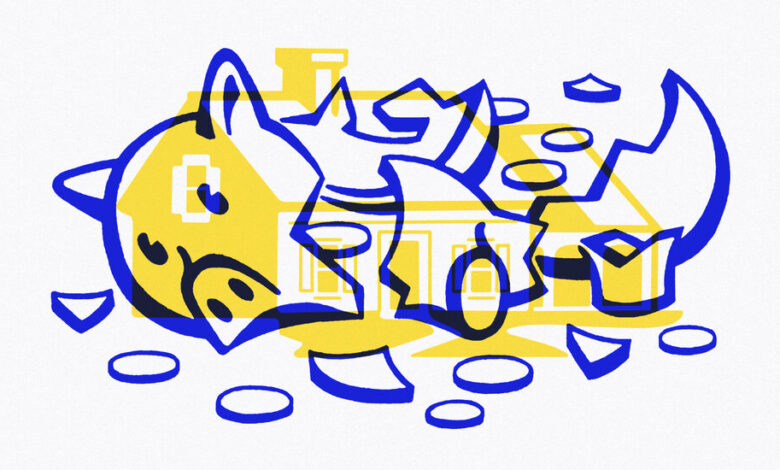What Does It Really Mean to Live ‘Paycheck to Paycheck’?

There are 17 songs on Napster with the title “Paycheck to Paycheck.” I know because I listened to all of them. (You’re welcome.) These aren’t covers — each has its own lyrics, some pretty good. I like the version by a singer-songwriter named Darrell Bailey because it refers to economists:
Recession or depression
It all sounds the same to me
On TV the experts try to tell us
It’s temporary for you and me
But in the meantime there ain’t no money
For the little man in the Land of the Free
When you’re living paycheck to paycheck
The hard times, they come free
The lyrics of the 17 “Paycheck to Paycheck” songs are about backbreaking work, bad bosses and past-due bills. They’re about people scraping by, on the edge of failure.
Given that, what should we make of the following claim? “Close to two-thirds of the U.S. population — about 157 million adults — currently live paycheck to paycheck, making it the main financial lifestyle in the United States.” That’s from a June report by the lending marketplace LendingClub in cooperation with PYMNTS.com, a payments data company. One-third of people earning $250,000 a year or more are living paycheck to paycheck, says the study, which was based on a survey and government data.
What the LendingClub report says to me is that we don’t have a good agreed-upon definition for what living paycheck to paycheck really means. If the definition of it encompasses almost two-thirds of Americans, I’d say, just looking around, that it’s too broad.
For example, let’s say you have a high income but you sock away money every month in a 401(k) plan for your retirement and a 529 plan for your kids’ education. You spend money on vacations, clothes, restaurants, home renovations. These expenses on average eat up all of your monthly pay. By one definition you’re living paycheck to paycheck, but you could pare back these expenses if you needed to.
It seems to me that “paycheck to paycheck” should be reserved for people whose monthly nut — unavoidable expenses like rent or mortgage, utilities, gasoline and food — consumes everything they bring home. One big emergency expense such as a transmission repair or hospital bill can break them.
Other surveys have found other results, generally less dire. MagnifyMoney, a unit of LendingTree, conducted a survey this year that found “50 percent of working Americans say they live paycheck to paycheck, meaning they have no money left after all expenses are paid.” WTW, a benefits consultant, said in June that “among workers earning $100,000 or more, the number of employees living paycheck to paycheck doubled from 18 percent in 2019 to 36 percent this year.”
It’s clear that survey methodology and question-wording matter. The Bank of America Institute says in a July 19 report that the percentage “does not seem as high as some media headlines” that put the figure over 50 percent. The institute says that across income groups, the share of spending that is discretionary is above 60 percent: “This tends to imply that while some people may be living paycheck to paycheck, they may still have scope to reduce their discretionary spending if they need to.” (That discretionary share sounds high to me, but I get the idea.)
Oddly enough, the Bank of America Institute found that customers with annual incomes of $250,000 or more are the most likely to have inflows to their accounts that are 15 percent or more smaller than the outflows from their accounts. That’s based on anonymized data from 40 million bank accounts for the first three months of this year.
Richer people who seem from their bank accounts to be spending beyond their means are probably pumping money into brokerage accounts and mortgage payments, which build housing wealth. They may get bonuses at times other than the first quarter, which is what the institute studied. And being older on average, they tend to have accumulated savings to draw on, David Tinsley, a senior economist at the institute, told me.
The good thing about the Bank of America Institute data is that it’s plentiful and objective, unlike surveys, which cover fewer people and are necessarily subjective. The bad thing is that you can’t always tell from financial flows why people are doing what they’re doing and how they perceive their own situations.
Surveys have a valuable role, and they’re better if they ask objective questions. I like the Federal Reserve’s annual survey, which asks people how they would pay for an unexpected $400 expense. The share who said they would cover it with cash or its equivalent — an indication of financial strength — has steadily risen, to 68 percent last year from 50 percent in 2013.
People’s ability to cover an unexpected expense grows if you give them a little more time. Fifty-five percent of U.S. adults say they “certainly” could come up with $2,000 if an unexpected need arose within the next month, according to an annual survey by the TIAA Institute and the Global Financial Literacy Excellence Center. That’s up from only a quarter who said so in the financial crisis year of 2009.
Annamaria Lusardi, a professor of economics and accountancy at George Washington University who co-directs the survey, told me that financial fragility is a serious issue in the United States, whatever the “paycheck to paycheck” surveys show. “I think we should still be alarmed,” she said. “Finance is becoming very complicated. It’s becoming difficult to make those decisions and very easy to be in trouble. There are so many opportunities to be in debt and spend. And few to save.”
Or as the singer Darrell Bailey told me when I reached him at home in Greenville, S.C.: “I have lived hard growing up. I know what it’s all about with nothing to eat in the house but sugar. I’ve always got up and went to work. I’ve lived both ends. I’ve worked since I was 16. I’m 53 now. You just pray for people who are having hard times. All you can do is get out and make a living every day.”
The Readers Write
Regarding your Wednesday newsletter on the efforts of the Federal Reserve Bank of Cleveland to create better estimates of gross domestic product, you wrote: “Think of their method as merging two wristwatches into one.” But as you noted, it wasn’t merely the two wristwatches they were merging — it was those and other time-keeping devices (if they are smart about it, every other clock or sundial or hourglass that they can get their hands on). As one of my co-workers is fond of saying: “There is no such thing as useless information. There is only information that is more or less trustworthy.”
Augustus P. Lowell
Durham, N.H.
Quote of the Day
“The greatest danger, that of losing one’s own self, may pass off as quietly as if it were nothing; every other loss, that of an arm, a leg, five dollars, a wife, etc., is sure to be noticed.”
— Soren Kierkegaard, “The Sickness Unto Death” (1849; translated by Walter Lowrie from the Danish, 1941)
Have feedback? Send a note to [email protected].





